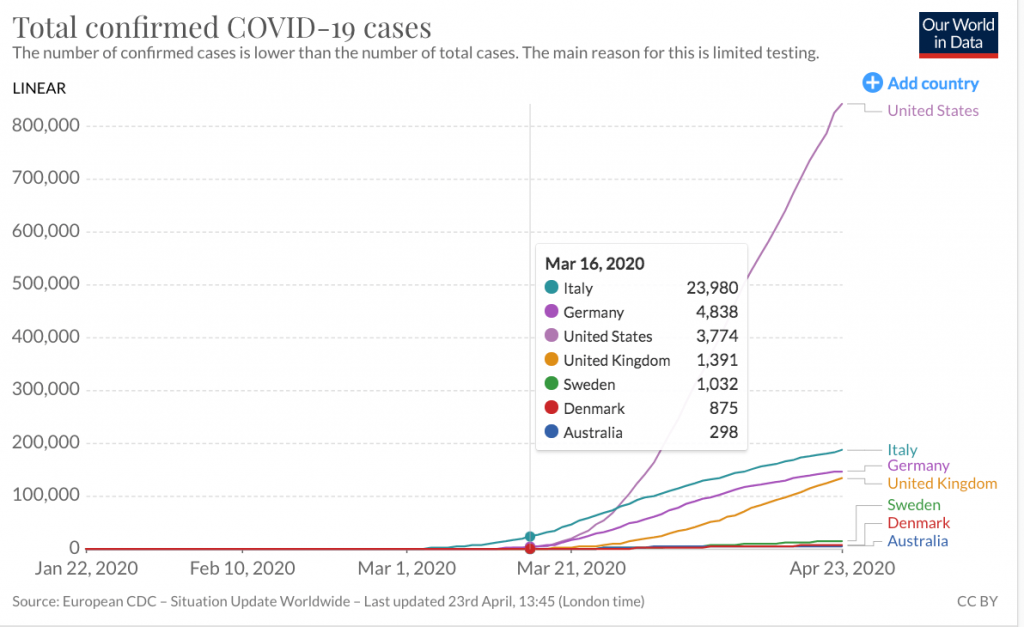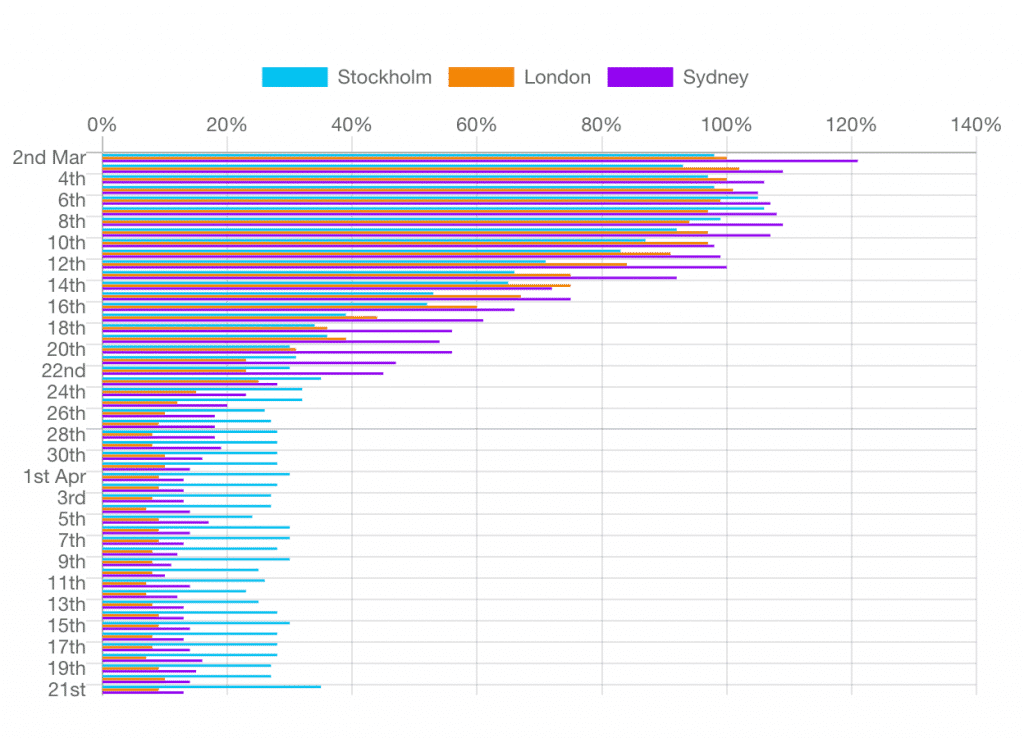Over the coming weeks and months we will all face an awful lot of challenges. There will be restrictions that prevent us from doing what we want to do, and seeing who we want to see. Toddlers have been inexplicably denied their favourite playgrounds. Grandparents denied their favourite toddlers. And young vivacious single people, in the prime of their lives, denied right to party like there is no tomorrow.
But each of these people; from age 2 to age 102, have made sacrifices for the greater good. And those sacrifices have put us in an enormously privileged position. Let me explain by way of comparison.
The chart below from Our World In Data shows that Australia is enormously privileged when it comes to having extremely low numbers of deaths per million, when compared to the United States, United Kingdom, Sweden, Denmark, Germany and Italy.
Now, there is no doubt some luck involved in this. Poor old Italy, for example, was simply infected so much sooner than Australia that it had fewer examples to learn from, and thus struggled to contain the outbreak as it should have.
But, as you can see if you hover your cursor over the chart above, as at March 15 we had suffered a similar number of casualties (per capita) to the USA, UK, Sweden, Germany and Denmark. With the possible exception of the USA, all these countries are widely considered rich, humane, developed first world nations who look after their populations. Even if the United States’ lack of universal healthcare excludes it from such characterisation, it is still the most powerful country on earth.
Not Just Luck
A friend of mine called me last night and let me know he was worried about his mother, over in the UK. You see, she’s not well at the moment, and the family thinks she has Covid-19. However, they can’t be sure, because the only way to get tested is to go to hospital, and you only go to hospital once you’re so badly off that you need their help. No-one wants to burden the NHS unnecessarily, you see. So she navigates the illness at home, without even knowing for sure what it is.
Not so in Australia. The chart below looks at the number of tests per million people in March. Since March, most of these other wealthy countries have ramped up testing. But to our credit, Australia was testing more than anyone else back in March when it really mattered.
Now, not all countries give standard or good data about how much testing they are doing. Given that the virus is virtually the same everywhere, absent an overwhelmed healthcare system (as in Italy) you would expect a similar case fatality rate (CFR) in all countries.
Where there are differences, a low CFR suggests your testing regime is picking up more cases, and a high CFR suggests your testing regime is picking up fewer cases. And once again, this measure suggests Australia is doing a really good job.
Swift And Strong Beats Slow And Slack
Besides testing, Australia has also shown its love for its fellow citizens in its response to the threat. If you recall, the first chart showed that we had similar deaths per person in mid March, when social distancing was starting.
But the chart below shows from Out World In Data that in mid-March the levels of infection itself were much lower than in other countries. While it makes sense to look at per-capita data in comparing outcomes between countries (answering questions around who let more of their citizens die and suffer), when tracking actual outbreaks and their progression you also need to look at absolute numbers. Well, on the basis of absolute numbers, Australia acted quite early relative to its own levels of infections.

The chart below from City Mapper shows that Sydney started locking down after both Stockholm and London. On March 15, Sydney was at 75% activity, London was at 67% and Stockholm was at 53%.

And yet, at March 15, London had the UK had recorded 1.4k infections, Sweden had recorded 1k infections, and Australia less than 300. Just a few days later we had less than 15% activity. That’s super important, since this University of Sydney study suggested we needed to reduce interactions by at least 80% to control the spread within a few months.
While Stockholm has not reached an 80% reduction in activity (according to City Mapper), London reached that goal on March 24, when the UK already had over 8,000 confirmed cases. And as we have seen from their much higher CFRs, it is likely Sweden and London had far more infections that they were not counting, compared to Australia.
And Sydney? We reached that 80% shutdown goal just one day later, on March 25, when Australia had about 2,400 cases. Our early action has saved countless lives.
What’s Next?
Inevitably, the next challenge for Australia is in opening up the economy without having Covid-19 infections grow out of control. That won’t be easy, but we can now, at least, act from a place of strength. In the UK, Italy and USA healthcare workers are dying in their hundreds. That is not only tragic, but also a semi-permanent disadvantage for their healthcare systems in dealing with future waves of the virus, if they occur. We have preserved the health of our essential healthcare workers.
Australia must now look to allow families to see each other. We must allow students to attend school. We must allow medical procedures. And we must allow young single people to see their friends. But all this must be done in a way that prohibits gatherings that can spread the disease like those bushfires we know too much about.
It would make sense to limit our interactions. For example, each person might have the right to see a maximum of one person outside their social distancing bubble each week. And then, if that works ok, it could go to two people. Then three. By acting early we have bought ourselves time to act smart. We should do so.
Thank You
On behalf of healthcare workers, who disproportionately suffer from Covid-19, thank you. On behalf of young children, who have a low chance of dying, but still suffer lung damage, thank you. On behalf of people with immune disorders or other pre-existing conditions, thank you. And of course, on behalf of our elders, thank you.
We are now in a position to minimise economic damage while also minimising loss of life. And that is where we want to be. Let’s make the most of it.
After all, you can bring an economy back to life but you can’t bring back a person.
If you’d like to receive a occasional Free email with more content like this, then sign up today!